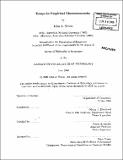| dc.contributor.advisor | Olivier J. Blanchard and Daron Acemoglu. | en_US |
| dc.contributor.author | Simon, John A. (John Albert), 1971- | en_US |
| dc.contributor.other | Massachusetts Institute of Technology. Dept. of Economics. | en_US |
| dc.date.accessioned | 2005-09-27T19:52:06Z | |
| dc.date.available | 2005-09-27T19:52:06Z | |
| dc.date.copyright | 2000 | en_US |
| dc.date.issued | 2000 | en_US |
| dc.identifier.uri | http://hdl.handle.net/1721.1/9006 | |
| dc.description | Thesis (Ph.D.)--Massachusetts Institute of Technology, Dept. of Economics, 2000. | en_US |
| dc.description | Includes bibliographical references (p. 76-80). | en_US |
| dc.description.abstract | This thesis consists of two separate essays. The first, entitled 'The Long Boom', considers the causes of the recent record breaking growth in the United States. The second, entitled 'Markups and Inflation', looks at the relationship between markups and inflation in the US and OECD. The first essay starts from the observation that economic growth in the 80s and 90s has been characterized by expansions significantly longer than the preceding post-war experience. An examination of the most recent cycles shows that they have been much less volatile than previous cycles. Investigation of the causes of this suggests that the shocks hitting the economy have been smaller rather than the structure being more stable. A structural decomposition finds that the volatility decline is concentrated in demand shocks and consumption volatility. The decline in consumption volatility is traced to a decline in the volatility of shocks with a permanent effect on consumption and a reduction in the reaction of consumption to temporary shocks. Examination of output volatility in other countries finds that the reduction in output volatility is a worldwide phenomenon. This suggests that the cause for the reduction in volatility is not confined to an individual country. Regardless, the conclusion. is that the prospects for future of economic growth in the US are good. The second essay calculates markups for 450 US manufacturing industries as well as 25 broader sectors in 14 OECD countries. These markups are compared with GDP deflater inflation. A significant and robust finding is that there is a negative correlation between inflation and markups. Furthermore, the strength of the correlation varies with industry concentration. Specifically, the markup in concentrated industries is more sensitive to inflation fluctuations than in unconcentrated industries. A model emphasizing the interaction of inflation with collusive behavior is then presented. The critical channel in this model is that the variance of cost shocks increases with inflation. Higher inflation and the concomitant increase in the variance of cost shocks makes the maintenance of collusive arrangements harder and, thereby, leads to a lower average markup. | en_US |
| dc.description.statementofresponsibility | by John A. Simon. | en_US |
| dc.format.extent | 80 p. | en_US |
| dc.format.extent | 7058097 bytes | |
| dc.format.extent | 7057859 bytes | |
| dc.format.mimetype | application/pdf | |
| dc.format.mimetype | application/pdf | |
| dc.language.iso | eng | en_US |
| dc.publisher | Massachusetts Institute of Technology | en_US |
| dc.rights | M.I.T. theses are protected by copyright. They may be viewed from this source for any purpose, but reproduction or distribution in any format is prohibited without written permission. See provided URL for inquiries about permission. | en_US |
| dc.rights.uri | http://dspace.mit.edu/handle/1721.1/7582 | |
| dc.subject | Economics. | en_US |
| dc.title | Essays in empirical macroeconomics | en_US |
| dc.type | Thesis | en_US |
| dc.description.degree | Ph.D. | en_US |
| dc.contributor.department | Massachusetts Institute of Technology. Department of Economics | |
| dc.identifier.oclc | 47443266 | en_US |
